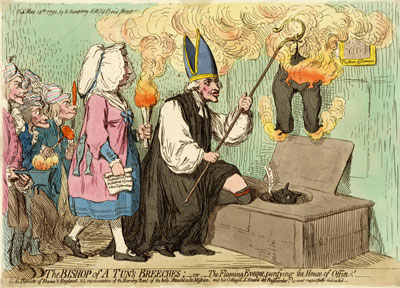The Bishop of A Tun's Breeches. . .
The impetus for this print was the widely reported, but fortunately unsuccessful, attempt on Wednesday, May 9th 1792 to set fire to the House of Commons. The attempt was made after hours, using a rolled up pair of breeches which had been lit and stuffed into the ceiling of a water closet along with some other combustible materials beneath the House itself. The perpetrators were never found, but suspicions naturally fell upon French representatives and sympathizers.

© Trustees of the British Museum
Gillray's tongue-in-cheek candidates for that honor are the former Bishop of Autun and de facto French Foreign Minister, Charles Maurice de Talleyrand-Périgord, and the Marquis de Chauvelin, the official French Minister Plenipotentiary to the English Court whose "Burning Zeal" is praised in the print's ironic dedication. Both were in London at the time of the attack, Talleyrand having arrived in January and Chauvelin in April just a few weeks before Gillray's print appeared.
Talleyrand is shown at the head of a revolutionary procession in bishop's regalia except for an exposed knee where his breeches would be. As a former member of the First Estate (the clergy) he had attended the first Estates General in 1789. But he later resigned his bishopric (April 21, 1791) becoming a common citizen and, in Gillray's eyes, aligning himself with the more radical and violent sans culottes shown at the far left. He holds his burning breeches from the end of his crozier like a censer before a picture of the House of Commons as if to purify it by fire.
The young Chauvelin is portrayed as a fishwife, thereby associating him with another group from the Third Estate, the poissardes who famously marched on Versailles in October of 1789, forcing the King and Queen back to Paris. In June of 1792, Gillray was to portray the violence of these fish wives in A Representation of the Horrid Barbarities Practised upon the Nuns by the Fish-Women on Breaking into the Nunneries in France.. Reinforcing the incendiary theme, Chauvelin carries in his left hand a torch of "Inflammatory Epis[tles]." One of those inflammatory espistles may have been the outright declaration of war against Austria that had been issued by the French less than a month earlier on April 20. It was that and the mounting resistance from Prussia and Spain who were itching to join Austria in the fight against France which prompted the diplomatic mission suggested by the paper in his other hand: "Instructions from the National Assembly to their Diplomatique."
As explained by the April 30 edition of the Evening Mail, the "mission" of Talleyrand and Chauvelin
was to obtain from our Government a promise to observe a perfect neutrality in case of war on the part of France against Prussia and Austria. The result is said to have been a promise of this neutrality, on condition that the French should, on their side, engage to leave the republic of Holland in possession of the same form of government which was given it by the Revolution of 1717; that they should neither 'attempt' nor favour any design against the power of the Stadtholder, and afford no assistance or encouragement to the Dutch patriots to renew their former projects.
Having spent most of his administration trying to get British finances under control, Prime Minister William Pitt was anything but eager to engage in an expensive war with France. But the new revolutionary government soon made that impossible by simultaneously declaring war on both Holland and Britain on February 1, 1793.
Sources and Reading
- Commentary from the British Museum on The Bishop of a Tun's Breeches.
- "Charles Maurice de Talleyrand-Périgord," Wikipedia
- "Bernard-François, Marquis de Chauvelin," Wikipedia
- "War of the First Coalition," Wikipedia
- "Women's March on Versailles," Wikipedia
- Thomas Wright and R.H. Evans, Historical and Descriptive Account of the Caricatures of James Gillray #75.
- Thomas Wright and Joseph Grego, The Works of James Gillray, the Caricaturist; With the History of His Life and Times, p. 150-151.
Comments & Corrections
NOTE: Comments and/or corrections are always appreciated. To make that easier, I have included a form below that you can use. I promise never to share any of the info provided without your express permission.